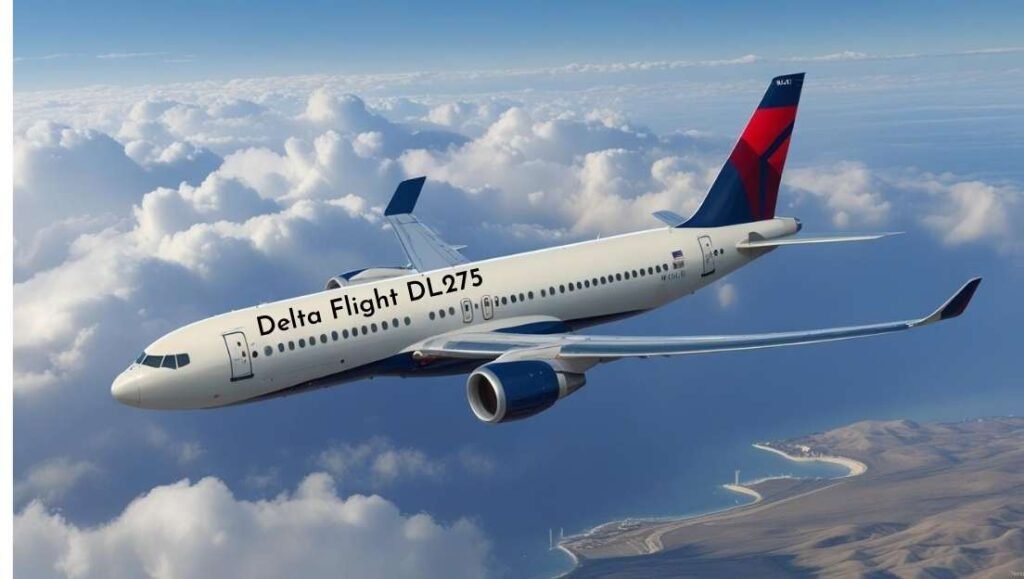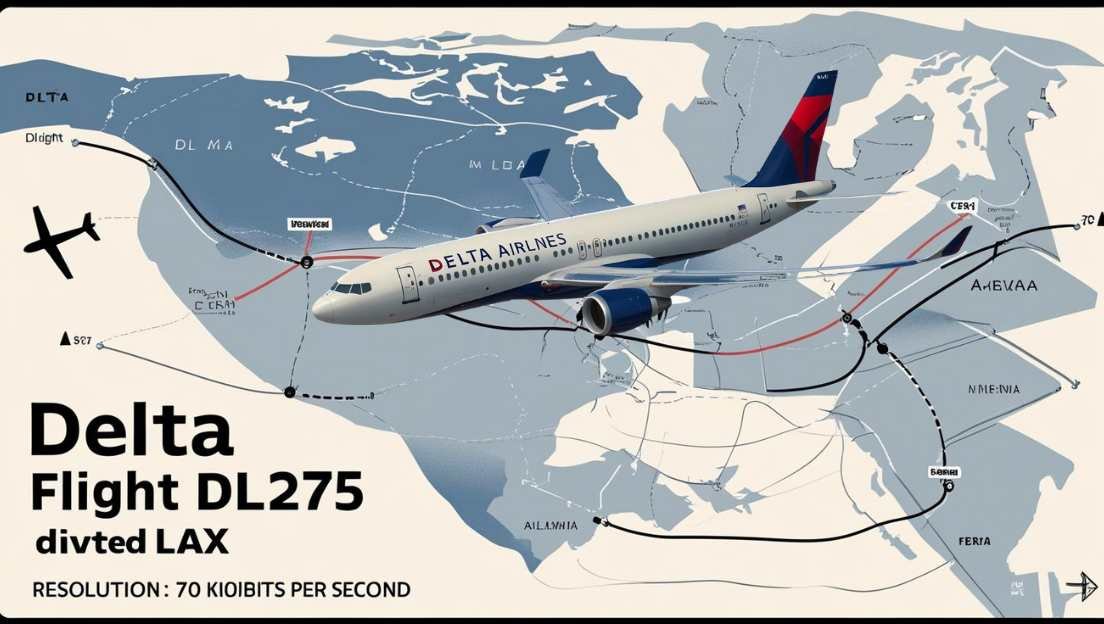Contents
- 1 Introduction – A Flight That Didn’t Go as Planned
- 2 What Happened on Delta Flight DL275?
- 3 Why Was Los Angeles Chosen Instead of Anchorage or Seattle?
- 4 Understanding the Anti-Ice System Problem
- 5 Could AI Have Prevented the Diversion?
- 6 Financial Impact on Delta Airlines
- 7 Passenger Experience During the Diversion
- 8 Effect on Delta’s Reputation
- 9 Lessons for the Aviation Industry
- 10 The Future: Smarter, Safer Skies
- 11 Conclusion – A Costly but Valuable Lesson
- 12 FAQs About Delta Flight DL275 Diverted to LAX
Introduction – A Flight That Didn’t Go as Planned
Every day, thousands of flights cross oceans and continents without any problems. Passengers board, relax, and arrive at their destination safely. But sometimes, even the most advanced aircraft face unexpected challenges.
That’s exactly what happened on May 28, 2025, when Delta Flight DL275 diverted to Los Angeles International Airport (LAX) after a serious engine system issue mid-flight. The flight, an Airbus A350-900, was originally traveling from Detroit Metro Airport to Tokyo Haneda International.
Thanks to the crew’s quick decision-making, all passengers and crew landed safely in Los Angeles. Still, the incident raised new questions about aircraft safety, airline costs, and the role of modern technology in preventing such emergencies.
What Happened on Delta Flight DL275?
The journey started like any other long-haul international flight. Passengers boarded in Detroit, the Airbus A350 took off smoothly, and the first few hours went by without issue.
But about five hours into the flight, while flying over the Pacific Ocean roughly 620 miles southwest of Anchorage, Alaska, the cockpit crew noticed serious alerts from one of the Rolls-Royce Trent XWB engines.
The warning showed a malfunction in the engine’s anti-ice system—a critical part that keeps ice from building up on engine surfaces during freezing, high-altitude flights. Without this system, ice could form, leading to reduced engine power or even complete failure.
Although there was no smoke or fire, the risk was too high to ignore. Continuing to Japan meant flying over remote and icy regions without quick access to emergency landing sites. The pilots decided to divert the flight to LAX, where Delta had strong facilities and technical support.
The flight landed safely at 1:08 AM local time, with no injuries reported.
Why Was Los Angeles Chosen Instead of Anchorage or Seattle?
Many people wondered why the crew chose Los Angeles rather than landing in Anchorage, which is geographically closer. The answer lies in several important factors:
Reasons for Choosing LAX
| Factor | Why It Mattered for DL275 |
| Maintenance Support | LAX has specialized Delta and Rolls-Royce technicians available to service Airbus A350 engines. |
| Runway Capacity | LAX has multiple long runways capable of handling heavy international aircraft landing with extra fuel. |
| Passenger Services | Hotels, food services, and rebooking options are easier to arrange from a major hub like LAX. |
| Delta Hub | Los Angeles is one of Delta’s U.S. hubs, making logistics for crew and passengers smoother. |
| Weather & Facilities | LAX had favorable weather and extensive emergency facilities at the time of diversion. |
Anchorage is often used for emergencies, but in this case, LAX offered the best mix of technical, safety, and passenger care options.

Understanding the Anti-Ice System Problem
The anti-ice system in modern jet engines prevents dangerous ice buildup. A component of the Trent XWB engine, the engine’s compressor hot air circulates to particular engine parts during the flight to cool and protect them.
On DL275, however, the system began to fail. The readings showed unusual performance:
| Sensor Data | Normal Range | Problem Reading on DL275 |
| Airflow | 100% | Dropped by 50% |
| Bleed Air Pressure | Stable | Down by 25% |
| Valve Response | Fast | 300% slower |
| System Temperature | Normal | 30% lower |
These signs meant ice could soon form on the engine’s internal parts, risking a dangerous failure. The pilots, following safety protocols, diverted the plane before the problem became critical.
Could AI Have Prevented the Diversion?
Yes—according to aviation experts, predictive maintenance powered by AI (Artificial Intelligence) could have flagged the issue before takeoff.
The A350 and many jets that came afterward gather in excess of 2.5 terabytes of data for each flight they make, an impressive amount of information to process. With advanced monitoring, AI can analyze this data in real time and compare it against thousands of past flights.
In this case, unusual patterns in airflow, valve speed, and temperature had been building up over earlier flights. AI tools could have detected these warnings 3–6 hours before departure from Detroit, giving mechanics time to repair the issue on the ground.
Industry studies show:
- Predictive AI can reduce unexpected failures by up to 78%.
- Airlines can save millions annually by avoiding cancellations and diversions.
Financial Impact on Delta Airlines
Although safety was the top priority, the diversion came at a heavy financial cost for Delta Airlines. The expenses included extra fuel, emergency landing fees, maintenance, and rebooking hundreds of passengers.
Estimated Costs of Delta DL275 Diversion
| Type of Cost | Amount (Approx.) |
| Extra Fuel | $180,000 |
| Landing Fees at LAX | $12,000 |
| Aircraft Inspection & Repairs | $95,000 |
| Crew Overtime & Hotels | $45,000 |
| Direct Flight Costs Total | $332,000 |
| Passenger Rebooking | $85,000 |
| Hotels & Food for Passengers | $50,000 |
| Compensation & Legal Costs | $41,000 |
| Passenger Costs Total | $176,000 |
| Lost Revenue from Cancelled Tokyo Leg | $1.98 million |
| Overall Financial Impact | ~$2.3 million |
For one single flight, that’s a huge financial loss.
Passenger Experience During the Diversion
For passengers, diversions can be stressful—even when everything is handled safely. On DL275, travelers experienced:
- Uncertainty: Passengers first heard about a “technical issue” mid-flight.
- Relief: The landing was smooth, and the crew remained calm throughout.
- Inconvenience: Missed connections, hotel stays, and delays affected business and personal plans.
- Support: Delta arranged hotels, meals, and rebookings, showing care for affected travelers.
Some passengers praised the crew’s professionalism, while others felt the issue could have been avoided if better maintenance had been done earlier.
Effect on Delta’s Reputation
Airline reputation is built on trust. Even though DL275 landed safely, events like these can hurt customer confidence.
Industry research shows that airlines may lose up to $2,800 in future bookings per affected passenger after a diversion. With over 300 people onboard, that could equal $840,000 in potential future losses.
However, Delta also earned respect from passengers who saw how well-trained pilots and flight attendants handled the emergency. This balance between risk and trust shows why communication and transparency are so important in aviation.
Lessons for the Aviation Industry
The diversion of Delta Flight DL275 is more than just an isolated incident—it’s a case study for airlines worldwide.
Key Lessons from DL275:
- Quick crew response saves lives. Training and decision-making remain the backbone of aviation safety.
- Traditional maintenance is not enough. AI and real-time monitoring must be used to predict issues earlier.
- Passenger care matters. How an airline treats people during diversions can protect—or damage—its reputation.
- Costs are massive. Even one diversion can cost millions, showing why prevention is critical.
The Future: Smarter, Safer Skies
The aviation industry is moving toward a future where connected aircraft systems will stream live engine data to engineers on the ground. This means potential problems can be spotted in real time and addressed quickly.
Regulators are also considering data-based inspection rules, requiring airlines to act on live sensor information rather than just fixed schedules.
By combining AI-powered diagnostics, predictive maintenance, and strong crew training, diversions like DL275 may become even rarer in the future.
Conclusion – A Costly but Valuable Lesson
The story of Delta Flight DL275 diverted to LAX is both reassuring and eye-opening. On one hand, it shows that the system works: the crew identified a problem, diverted safely, and no one was harmed. On the other, it highlights the financial, emotional, and trust-related costs of such incidents.
In the end, the message is clear:
- Safety comes first—always.
- Prevention is better than reaction—technology must play a bigger role in modern aviation.
For Delta, the diversion was expensive. But for the entire industry, it might become the turning point toward smarter skies.
FAQs About Delta Flight DL275 Diverted to LAX
1. Why did Delta Flight DL275 divert to LAX?
Because of a malfunction in the engine’s anti-ice system, which could have caused dangerous ice buildup mid-flight.
2. Was it an emergency landing?
Yes, it was treated as a precautionary emergency, but the plane landed safely without injuries.
3. Which aircraft was involved in the flight?
It was an Airbus A350-900, with the Trent XWB engines produced by Rolls Royce.
4. How much did the diversion cost?
The total financial impact was about $2.3 million, including repairs, fuel, passenger rebooking, and lost revenue.
5. Could the problem have been avoided with AI?
Yes. AI-based systems could have registered the alerting signals prior to the aircraft’s scheduled time, and thus, the flight would not have had to get redirected.
6. Where was the flight originally going?
It was scheduled to fly from Detroit (DTW) to Tokyo (HND).
7. How many passengers were affected?
Over 300 passengers were delayed, rebooked, or provided with accommodations.
8. Did everyone land safely?
Yes, the aircraft landed at LAX at 1:08 AM local time, and no injuries were reported.
